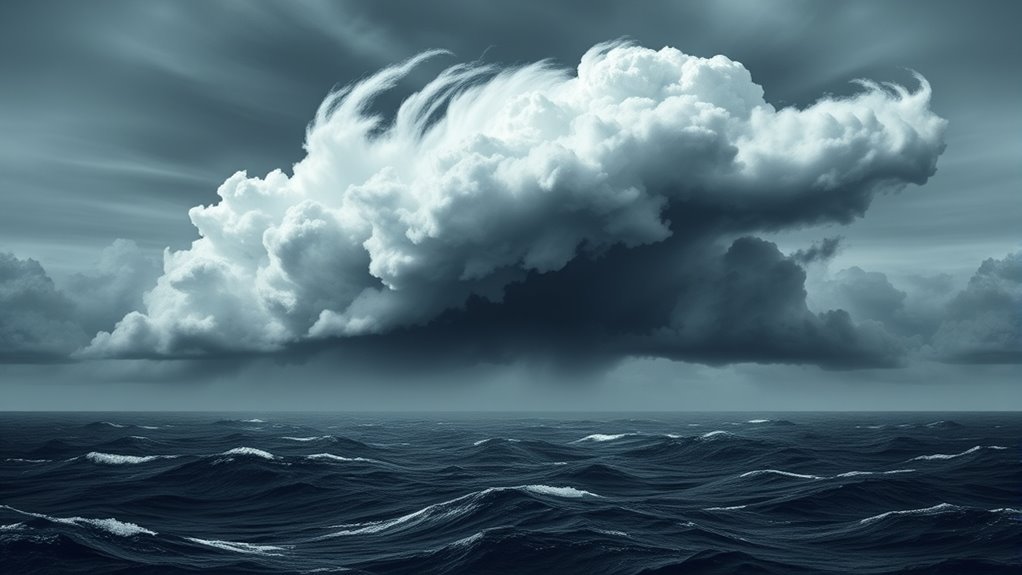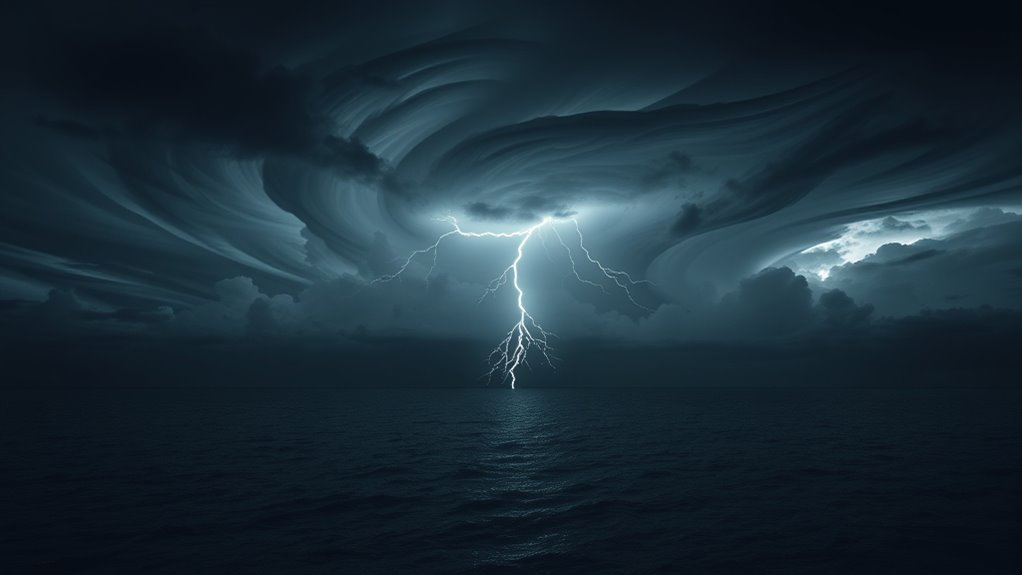Squalls are sudden, intense bursts of wind and precipitation linked to high-impact weather systems. Often preceding severe weather, these phenomena result from atmospheric instability and the rapid ascent of warm, moist air. Their unpredictable nature can lead to flash flooding and severe thunderstorms, affecting local weather patterns considerably. Understanding the relationship between squalls and severe weather can improve preparedness. Various notable squall events highlight the importance of monitoring these occurrences closely, revealing more about their effects and consequences.
Main Points
- Squalls often precede high-impact weather systems, acting as indicators of severe weather events along cold fronts.
- Intense downdrafts during squalls can lead to rapid temperature drops and shifts in wind direction, signaling severe weather.
- The interaction of differing air masses during squall formation can enhance the intensity of storms, increasing severe weather risks.
- Squalls can trigger severe phenomena, including hail and tornadoes, contributing to overall weather system severity.
- Understanding squalls is crucial for accurate weather forecasting, enhancing preparedness for high-impact weather events.
Understanding Squalls: Definition and Characteristics
Squalls are sudden, intense bursts of wind accompanied by precipitation, often occurring within larger weather systems. Defined by their abrupt onset, squalls can lead to rapid changes in weather conditions, including sharp drops in temperature and visibility.
These phenomena are typically short-lived but can be quite powerful, creating hazardous conditions for aviation, marine activities, and outdoor pursuits.
In addition to wind and rain, squalls may present other weather elements such as hail or thunder, although not all squalls exhibit these features. The intensity of a squall can vary, ranging from mild gusts to severe wind events that pose risks to structures and transportation.
Understanding the nature of squalls is essential for weather forecasting and safety measures, as their unpredictable nature can catch individuals unprepared.
Altogether, squalls serve as a reminder of the dynamic and sometimes violent character of atmospheric conditions.
How Squalls Develop: Meteorological Processes

The development of squalls is intricately linked to specific meteorological processes that create the conditions necessary for their formation. These phenomena typically arise from the interaction of atmospheric instability, vertical wind shear, and the presence of a triggering mechanism, such as a cold front or a topographical feature.
When warm, moist air is forced to rise rapidly due to these triggers, it can lead to the rapid development of convective cells. As these cells grow, they may organize into squall lines, distinguished by intense precipitation and strong winds. The release of latent heat during condensation further fuels the convective process, enhancing the storm's intensity.
Additionally, the interaction between differing air masses—like the collision of warm and cold fronts—can exacerbate the development of squalls, leading to localized severe weather events. Understanding these processes is essential for predicting and mitigating the impacts of squalls on various regions.
The Role of Temperature and Humidity in Squall Formation
While various factors contribute to the formation of squalls, temperature and humidity play essential roles in determining their intensity and occurrence. Raised temperatures create a conducive environment for the rapid upward movement of warm, moist air. This rising air can lead to noteworthy instability in the atmosphere, which is essential for squall development.
When warm air ascends, it cools, leading to condensation and the formation of clouds. Humidity is equally important; higher moisture levels improve the potential for precipitation and the release of latent heat during condensation. This heat further fuels the updrafts, intensifying the squall.
Conversely, lower humidity can inhibit squall formation, leading to weaker weather systems. As a result, the interplay between temperature and humidity is fundamental in shaping the dynamics of squalls, affecting both their formation and intensity in various weather scenarios.
Understanding this relationship is essential for predicting squall events and their subsequent impacts.
Squalls as Indicators of Severe Weather Systems

As atmospheric conditions shift, squalls often serve as crucial indicators of impending severe weather systems. These short-lived bursts of strong winds and precipitation can signal the approach of more notable meteorological events, such as thunderstorms or hurricanes.
Meteorologists closely monitor squall lines, which typically form along cold fronts, as they often precede severe weather outbreaks. The intense downdrafts associated with squalls can lead to sudden temperature drops and shifts in wind direction, further indicating the instability of the atmosphere.
Additionally, squalls can increase the likelihood of severe weather phenomena, including hail, lightning, and tornadoes. Their occurrence is frequently accompanied by rapid changes in atmospheric pressure, which serve as additional warning signs for forecasters.
Recognizing squalls as precursors to severe weather allows for timely warnings and preparedness measures, ultimately reducing the risk to life and property.
The Impact of Squalls on Local Weather Patterns
Squalls considerably influence local weather patterns, particularly through temperature fluctuations and variations in precipitation.
These sudden bursts of intense weather can lead to quick changes in atmospheric conditions, affecting both immediate and longer-term climate dynamics.
Understanding the relationship between squalls and these elements is essential for accurate weather forecasting and climate analysis.
Squalls and Temperature Changes
The occurrence of squalls can lead to considerable temperature changes in local weather patterns. These abrupt weather events, defined by sudden gusts of wind and brief periods of intense precipitation, often result in sharp declines in temperature as cooler air is introduced.
This phenomenon is particularly evident in coastal areas, where squalls can draw down frigid air from offshore waters, leading to a rapid drop in local temperatures. Additionally, squalls can create a stark contrast with preceding warm conditions, resulting in a noticeable shift in the thermal profile of the region.
Such temperature fluctuations can influence local ecosystems, affect human activities, and alter the dynamics of air masses, highlighting the notable role squalls play in shaping weather variability.
Precipitation Variability Effects
Local weather patterns are considerably influenced by squalls, particularly regarding precipitation variability. These sudden weather events can lead to notable changes in local rainfall distribution, affecting both agriculture and water resources.
The impact of squalls on precipitation variability can be observed in several ways:
- Intensity of Rainfall: Squalls often produce heavy, short-duration rainfall, which can lead to flash floods.
- Spatial Distribution: The localized nature of squalls causes uneven rainfall, with some areas receiving substantial precipitation while neighboring regions may remain dry.
- Duration of Effects: Following a squall, precipitation patterns can shift, leading to alterations in longer-term weather forecasts.
Thus, understanding squalls is essential for predicting changes in local weather patterns and managing their consequences effectively.
Precautions and Safety Measures During Squalls
Understanding the signs of an impending squall is essential for safety.
An effective emergency preparedness checklist can help individuals stay organized and ready for sudden weather changes.
Identifying safe shelter locations further improves one's ability to respond effectively during these severe weather events.
Recognizing Squall Signs
Recognizing the signs of an impending squall is essential for ensuring safety during unpredictable weather events.
Awareness of these indicators can greatly reduce risks for individuals and communities.
Key signs to watch for include:
- Rapid Wind Shift: Sudden changes in wind direction and speed often precede a squall, indicating its approach.
- Darkening Skies: An abrupt increase in cloud cover, particularly dark, ominous clouds, can signal an imminent squall.
- Temperature Drop: A noticeable decrease in temperature, especially in a short time frame, is a common precursor to squall activity.
Emergency Preparedness Checklist
An effective emergency preparedness checklist is essential for individuals and communities facing the threat of squalls. This checklist should include several critical items.
First, it is important to guarantee that an adequate supply of non-perishable food and water is available for at least three days. Flashlights, batteries, and a first aid kit are also essential for safety during power outages.
Additionally, residents should have a battery-operated weather radio to receive updates. Important documents, such as identification and insurance papers, should be stored in a waterproof container.
Finally, a communication plan should be established, ensuring that family members know how to reach one another during emergencies. By following this checklist, individuals can improve their readiness for squall-related impacts.
Safe Shelter Locations
When squalls approach, identifying safe shelter locations becomes essential for ensuring personal safety and minimizing risks. Individuals should prioritize finding sturdy structures that can withstand harsh weather conditions.
It is vital to avoid areas prone to flooding or falling debris.
Here are three safe shelter options to evaluate:
- Indoor Spaces: Seek refuge in basements or interior rooms of sturdy buildings, away from windows.
- Community Shelters: Identify local community centers or schools designated as emergency shelters during severe weather.
- Vehicles: If no other options are available, staying in a vehicle with the windows closed can provide temporary protection, though it may not be ideal during extreme squalls.
Being aware of these locations can help mitigate the dangers associated with squalls.
Case Studies: Notable Squall Events and Their Consequences
Squalls, marked by rapid changes in wind and intense precipitation, have frequently played vital roles in shaping local weather patterns and impacting communities. Notable squall events illustrate their potential consequences.
For instance, the 2018 squall in the Midwest resulted in sudden gusts exceeding 70 mph, leading to widespread power outages and tree damage. In another case, a 2020 squall in the Southeastern United States produced torrential rain, causing flash flooding that disrupted transportation and forced evacuations.
Additionally, squalls have been linked to severe thunderstorms, as seen in the 2019 event in the Northeast, where a squall line prompted tornado warnings and considerable property damage.
These case studies underscore the need for improved monitoring and preparedness strategies, as the rapid onset of squalls can pose considerable risks to public safety and infrastructure. Understanding these events aids in developing more effective response plans for future occurrences.
Common Questions
How Do Squalls Differ From Other Weather Phenomena?
Squalls are defined by sudden, intense wind and precipitation, distinguishing them from other weather phenomena. Unlike steady rain or gradual temperature changes, squalls occur abruptly, often associated with severe weather, and can considerably impact local conditions.
Can Squalls Occur in Any Season?
Squalls can occur in any season, as they are primarily driven by atmospheric conditions rather than specific seasonal patterns. Their presence is influenced by factors like temperature changes and moisture levels, enabling them to manifest year-round.
What Tools Are Used to Predict Squalls?
Meteorologists utilize various tools to predict squalls, including radar systems to detect precipitation patterns, satellite imagery for cloud formation, and atmospheric models to analyze temperature and pressure variations, thereby enhancing forecasting accuracy for these sudden weather events.
Are Squalls More Common in Certain Regions?
Squalls tend to be more prevalent in specific regions, particularly coastal areas and places with considerable temperature contrasts. These factors contribute to the frequency and intensity of squall events, impacting local weather patterns and conditions.
How Long Does a Typical Squall Last?
A typical squall lasts approximately 20 to 30 minutes, defined by a sudden onset of strong winds and heavy precipitation. The duration can vary depending on local atmospheric conditions and the specific weather system involved.

